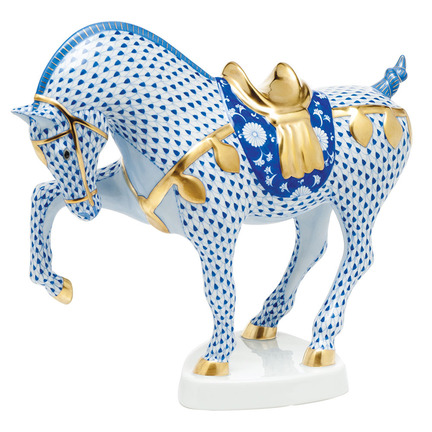This is a true story:
In 1989, the British Rail Pension Fund showed the finest Tang Dynasty porcelain horse ever found at a Sotheby’s Hong Kong Auction. That same night, thieves broke into the Sotheby’s warehouse, held the staff at knife point, and made off with the horse. The heist made headlines around the world, and the Hong Kong organized crime squad was called in. They set up a sting operation, pretending to be buyers, and recovered the stolen horse. It was then transported in a convoy of seven armored cars and sent to London, where on December 12, 1989, it sold for a record-setting 3.74 million pounds, or $6 million ($10.7 million today after inflation) to an art dealer from Tokyo.

Such excitement is just another page in the history of the legendary horses. During China’s Tang dynasty, horses were loved and revered as symbols of imperial power. Emperors and noblemen gave them names like “Wind” or “Dragon.” Poets rhapsodized about them. Artists created porcelain horses that captured their strong, muscular builds in life-like poses. Merchants, on the other hand, were forbidden from riding horses — such a noble creature was not to be wasted on the ostentations of the merely wealthy.
Today, Tang horses are among the best-known Chinese art. Relatively ordinary ones are selling for about $250,000, while a premium pair sold at Sotheby’s in 2013 for almost $4.2 million. For your collection of Tang horses, here are some things to keep in mind:
- Most Tang horses are only 15 inches tall.
- All Tang horses are made from ceramic.
- They were made to accompany the rich and powerful in the afterlife and buried with their owners.
- Most Tang horses are equipped with full riding gear.
- Almost all Tang horses have highly stylized, combed manes and a short, upturned tail.
- They come in both glazed and unglazed versions.
- The glazed versions usually come in three colors, hence the Chinese term sancai or “Three Color” horse.
- Of the glazing colors, cobalt blue is the rarest and most prized. Only 5 percent of Tang horses have the blue cobalt glaze, which was more expensive than gold at the time.
- Tang horses have traditionally appealed more to Western than Chinese buyers, who avoided them as burial goods.
As a gallery specialist recently told The New York Times, “You want crisply defined medallions, beautifully articulated, hand-finished faux-fur saddlecloths and harnesses with bells and floret motifs. When all these elements are perfect, you’ve got a home run.”
While you wait for the next one to come up for auction, here are a couple of modern versions to add to your collection. L’Objet’s unglazed Tang horse in large or medium, has a zen and modern look:

Herend’s limited edition Reserve Collection Tang Horse reinterprets the Tang original in the company’s signature sapphire blue fishnet design, with 24kt gold highlights:

Do you think today’s designers have outdone the ancient masters?

Comments
2 responses to “Collecting the Tang Dynasty Horse”
Hi,
I am trying to find out how the markings on the underside of the Tang Sancai horses can help to date them. Can you help me decipher this mystery? Some marks are inside a diamond shape and some have no mark.
Thank you,
Sandy
Sorry but that is not something we could help with. Perhaps it would be better to contact an antiques dealer that specialized in them.